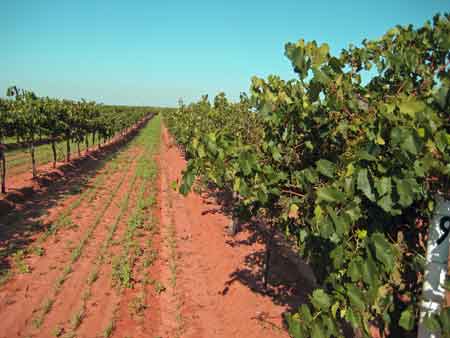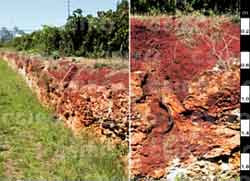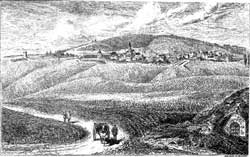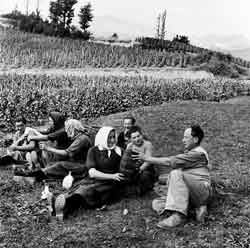
Terroir: A “Land – Man” Conjunction
Earlier this year, I visited the Texas High Plains to observe the grape harvest. As I chronicled my trip and experience on this blog, I had an intimate awareness of what wine writers and even more French viticulteurs describe as “terroir”. In a search for words at the time, I tried to capture the experience and blogged…..
“The scenery is dominated by red-brown dirt and sky that gives me the feeling that I was viewing the land that was created very early on the morning of third day of creation. This was before God had yet worked up the idea of making high mountain vistas on the newly created land.” See: https://vintagetexas.com/?p=27
I also had the impression that this was a very special place….land made of natural elements but where uniquely human elements of grit and determination had been applied. This region was first used for open range cattle grazing. “New technologies” – barbed wire and windmills – first looked at with suspicion, led to improved herds and eventually sustained the region’s agriculture boom of corn, cotton, and soybeans. We are now in the offing of a potentially new boom time….for wine grapes.
This near-religious, Texas High Plains experience helped set me on my journey to better understand the definition of the word terroir and even more specifically the meaning of our own special brand of “Texas Terroir”.
Texas High Plains “Tierra Roja”
A more “down to earth” description of the Texas High Plains Terroir came from grower, Neal Newsom.….
[We have] “red sandy loam on top of caliche limestone, which is typical on the Texas High Plains. It is a perfect, disease resistant soil for grape growing since the red sandy soil has good mineral content and drains rapidly. The underlying caliche allows the roots from the vines to easily penetrate deep underground. It also holds on to the moisture draining through the top soil throughout the year, even when the vine are dormant. This can give the vines a source of water that they can use all year long.” See: https://vintagetexas.com/?p=30
 Several months after this trip, I was amazing to compare Neal’s words with the common description of the soil in one of the world’s most notable growing regions – The Coonawarra, the most sought-after vineyard soil in Australia, known as Terra Rossa (red earth). It is located in South Australia, some 375 kilometers (230 miles) from Adelaide and slightly further from Melbourne. This fertile soil’s unique rusty-red color is due to its mineral content of iron oxide. It covers bedrock of porous limestone, assisting good drainage but offering summer moisture retention. This has made Coonawarra one of the greatest regions in the world for growing Cabernet Sauvignon. These conditions produce low-yielding and intensely flavored grapes, helped along by the climate of long dry warm autumn days and cool nights during the key ripening period.
Several months after this trip, I was amazing to compare Neal’s words with the common description of the soil in one of the world’s most notable growing regions – The Coonawarra, the most sought-after vineyard soil in Australia, known as Terra Rossa (red earth). It is located in South Australia, some 375 kilometers (230 miles) from Adelaide and slightly further from Melbourne. This fertile soil’s unique rusty-red color is due to its mineral content of iron oxide. It covers bedrock of porous limestone, assisting good drainage but offering summer moisture retention. This has made Coonawarra one of the greatest regions in the world for growing Cabernet Sauvignon. These conditions produce low-yielding and intensely flavored grapes, helped along by the climate of long dry warm autumn days and cool nights during the key ripening period.
Is it any wonder why our very own Texas High Plains “Tierra Roja” has produced rich, full-bodied Cabernets? How these particular soil conditions developed on the Texas High Plains and in Coonawarra may be different, but the results are undeniably similar. There are now about 13,590 acres of vineyards planted on the Australian Terra Rossa, half of them dedicated to Cabernet Sauvignon. We have only 3,900 acres planted in wine grapes in all of Texas. Now, the task is ours to work with these special soils to expand and optimize vineyard production and bring these wines to play a great performance on the world stage.
Let’s Take a Moment to Define Terroir
Now that we have identified one of potentially many terroirs in Texas, we need to make sure that we all understand what we mean by the use of the word…Terroir. Definitions for this word have been attempted by more wine writers than I care to count. But, a clear depiction of this seemingly simple term has been quite elusive. One apparently straightforward description of terroir comes from my favorite and oft used source – Spoonmaker’s Encyclopedia of Wine:
“Terroir (pronounced – tair-wah’r): A French word for “soil” or “earth” that is used in an extended sense to describe the soil together with the associated climatic conditions of a district or vineyard; the English equivalent might be mesoclimate.”
However, to me this description seems to be a bit limited, especially when terroir is morphed into the simple scientific-sounding English word, “mesoclimate”. In making this French-English conversion, the element of “extended sense” is lost, or at least severely limited. In my discussions with French vignerons (growers), some linger more on the “extended sense” of the word than on the more obvious aspects that come directly from the soil or the climate. Most importantly, they address aspects that can only be described in the big picture as a “sense of place”.
As noted by Johnson & Halliday in their book, The Vintner’s Art, Bruno Prats previously of Chateau Cos d’Estournel in Bordeaux, France describes terroir as all of the natural conditions that influence the biology of the growing vine stock and thus the composition of the grapes themselves. He lists several of these components to be climate, soil, and landscape. He also acknowledges that there is still something more, conceding in the final analysis that even this description is deficient in its ability to capture the true spirit of terroir.
 We know that the rudimentary concepts of terroir were first examined in the first millennium A.D. by the Benedictine monks and shortly thereafter by the Cistercians in the 11th century in what is now France and Germany. They used their senses, judgment and trail-and-error experimentation to indentify the best sites for grape cultivation and best grape varieties….but, best for what?
We know that the rudimentary concepts of terroir were first examined in the first millennium A.D. by the Benedictine monks and shortly thereafter by the Cistercians in the 11th century in what is now France and Germany. They used their senses, judgment and trail-and-error experimentation to indentify the best sites for grape cultivation and best grape varieties….but, best for what?
This question leads us to another element in what I feel is inherent in the definition of terroir, and the part that this often missed. It is the human influence, and the related perception of compatibility of wine with a local food culture that we now call cuisine. As in the case of the Benedictines and Cistercians, regional culture and cuisine undoubtedly influenced the vignerons (growers).
The decidedly human activity of grape cultivation is a force (just as powerful as soil and climate) that can also influence the composition and characteristics of the grape as do the nature elements. This comes over time through grape selection and adaptation, development of growing and pruning practices and even the application of locally specialized harvesting techniques to provide grapes with particular characteristics. Examples are the use of particular blends of grapes (up to thirteen varietals) in the Rhone Valley, the use of the “Noble Rot” fungus in the production of sweet wines of Sauternes, and the selective hand-harvesting techniques used in Trockenbeerenauslese (the highest category in the Prädikatswein category of the Austrian and German wine classifications).
Admittedly, Texas has an evolving wine culture. But, while this culture has historical roots going back to the Spanish missionaries over 400 years ago, Texans only entered the modern wine world in the 1970s. As with most new emerging wine producing regions, Texas started by growing grapes and producing wines that people could recognize. This is why the first wines “out-of-the bottle” so-to-speak in new regions are commonly Chardonnay, Cabernet Sauvignon and Merlot. While the names of these varietal wines are recognizable for consumers, new regions may pose particular difficulties for these varietals.
A case in point for Texas has been Chardonnay. While Texas has produced some noteworthy Chardonnays, this grape is very difficult to grow here leading to a decline as the vines increase in age. In some locales, Texas growers have found ways to grow noteworthy Cabernet Sauvignon, such as in the Texas High Plains. Is it as easy to grow Cabernet in Texas as in California or in France? The answer, at least to date, simply put is….No. But, we are learning and the “instruction manual” is still being written as we taste today.
From recent reports, Texas seems to have entered a new phase of development also common to other new producing regions. Texas growers have looked around the world for wine producing regions that are more like Texas, having warm weather growing conditions. Examples of these regions include southern France, Spain, Italy and even some parts of Australia. From this introspection, vignerons in Texas have been planting different kinds of grapes – Reds: Syrah, Grenache, Mourvedre, Sangiovese, Tempranillo; Whites: Viognier, Rousanne, Pinot Grigio and Vermentino. The results of these “experiments” have been rewarding despite the fact that the vines are still rather young by comparison to those in their native homelands. These grapes are producing fresh, lush wines that take in the hot Texas sun and figuratively ask for more. I contend that this conscious human decision to change to warm weather grape varietals in Texas is part of our Texas terroir simply based on Bruno Prats’ definition of terroir. This Texas human element has consciously influenced the biology of the growing vine stock and thus the composition of the grapes themselves in the same way that growers did over 900 years ago in Europe.
Are we making progress? My answer is a resounding yes! This answer comes despite some hard growing seasons of late rife with late freezes, drenching rains and Pierce’s Disease – our ever-present “Sword of Damocles”. My initial proof was presented in my first blog postings on VintageTexas.com. It was obtained when I shared our Texas wines with noted food and wine specialists in Bandol and Gigondas in the Southern Rhone region of France.
See: https://vintagetexas.com/?p=1 & https://vintagetexas.com/?p=3
But now, Texas appears to be entering yet a third era for its wine production which is also akin to what the Benedictines and Cistercians did a thousand years earlier, but with we have the added benefit of modern science to help quicken the pace. In this portion of the Texas wine evolution, growers are working with a range of grape varietals, the soil and climate, but are applying another human element to make mindful changes. Growers are implementing techniques that will eventually produce Texas wine of true distinction that will meld with our culture and cuisine to define a true Texas Terroir.
The Land-Man Conjunction
 My broader approach to defining terroir has been accepted by Sommers in his book “The Geography of Wine” in which he recognizes the seminal work of Pattison in the 1960s to define geography in terms of “land-man” study (sometimes called human ecology). This approach builds on soil chemistry and climatic conditions on determining grape composition, adding the influence of humans. Sommers emphasizes that the scientific community has only in the 1960’s begun to appreciate this “Land-Man Conjunction” when studying and understanding agricultural societies. But, he acknowledges that the French were on to this concept back in the 1800’s, traced back to the work of La Blanch. He sent his geography students into the countryside to live and study in the French wine regions. They produced descriptive monographs chronicling the land-man interactions of people, local cultures and grape production.
My broader approach to defining terroir has been accepted by Sommers in his book “The Geography of Wine” in which he recognizes the seminal work of Pattison in the 1960s to define geography in terms of “land-man” study (sometimes called human ecology). This approach builds on soil chemistry and climatic conditions on determining grape composition, adding the influence of humans. Sommers emphasizes that the scientific community has only in the 1960’s begun to appreciate this “Land-Man Conjunction” when studying and understanding agricultural societies. But, he acknowledges that the French were on to this concept back in the 1800’s, traced back to the work of La Blanch. He sent his geography students into the countryside to live and study in the French wine regions. They produced descriptive monographs chronicling the land-man interactions of people, local cultures and grape production.
Today, in the Texas wine experience, we are on hand for exciting times. Growers and winemakers are continuing to learn, understand and utilize what the natural god-given elements of soil and climate provide. But, they are also working with the human element, to make changes, selections and adaptations that will define our own uniquely Texas Terroir. This will require our continued dedication to the vintage-by-vintage task of increasing the quality and character of Texas wines and to adapt these wines with our local Texas cultures and cuisines. In this process, we are looking for wines that complement not just gourmet fare, but nicely harmonize with local meat and seafood preparations and the smoky, spicy and succulent condiments that accompany them. Additionally, these wines need to be compatible with the ethnic palates that will persist in Texas and they need to reflect price points affordable for daily meal-time consumption.
This is a considerable task, but the journey will be wonderful to observe and experience. I hope every wine-loving Texas signs-on for the voyage and makes his/her comments part of the evolutionary process for our own Texas Terroir.

Boomtime Bigger Than Texas
by PHILIP WHITE
as posted on Drinkster (an Aussie Blog) on 08 January 2009 at:
http://drinkster.blogspot.com/2009/01/texan-docs-dreamtime-coonawarra-mk-ii.html
So who can learn from Maynard?
Texas, that’s who.
Texas has up and got Coonawarra envy.
Another freaky blog in the Jesus’ birthday period came from Houston wineslinger, Doc Russ Kane.
His scholarly piece is at vintagetexas.
I reckon I met Russ and his wife Delia Cuellar over a pit in the Flinders Rangers the year the Space Shuttle exploded. The pit had three big kangaroos in it. My brother Joe McKenzie, senior man of the Adnyamathanha nation, was showing the visiting wine and food writers how to cook roos. He was burning the hair off ’em with a eucalypt fire.
When you burn the hair off kangaroos it stinks.
“Oooh Ma Goodness!” hollered the lady. “Wheredjouwall learn to do that?”
Joey looked at me incredulously.
“Looked it up on the internet, Missus”, he said, expertly flipping the roos by their tails.
Before Texas goes too far down the track of emulating Coonawarra, or, similarly, our Murray-Darling Basin, it might take moment to get on the internet and read CADUCEUS and Wine Biz On The Nose, an angry diatribe I hissed onto this site on NewYear’s Day.
“Terroir: A ‘Land – Man’ Conjunction” was the headline that caught my eye. Doc Russ had been up on the Texas High Plains to observe the grape harvest.
It is this very terroir that makes the Coonawarra little different from the rest of the sedimentary Murray-Darling Basin. Only Coonawarra’s proximity to the sea makes it different. Otherwise, it’s mainly been over-irrigated, minimally-pruned, scorched earth, grossly overyielding monocultural grapeyards that look and feel more like the Nuremberg Rallies than a garden for food.
Just like our Riverland. Which is cactus. You don’t mention ‘boom-time’ in Coonawarra or the Riverland these days.
“Is it any wonder why our very own Texas High Plains ‘Tierra Roja’ has produced rich, full-bodied Cabernets?” Russ asks. “How these particular soil conditions developed on the Texas High Plains and in Coonawarra may be different, but the results are undeniably similar. There are now about 13,590 acres of vineyards planted on the Australian Terra Rossa, half of them dedicated to Cabernet Sauvignon. We have only 3,900 acres planted in wine grapes in all of Texas. Now, the task is ours to work with these special soils to expand and optimize vineyard production and bring these wines to play a great performance on the world stage.”
Coonawarra and the Riverland are as close as Australia’s ever got to that other peculiarly American metaphor Ross aptly includes in his considered piece: the corn boom.
Read The Omnivore’s Dilemma, by Michael Pollan. I can’t possibly paraphrase that essential work…. And don’t forget CADUCEUS.
Philip, thanks for the comments from half way around the world, but still in our “backyard”
Russ
COMMENT FROM VINTAGE TEXAS on Drinkster at:
COONAWARRA ENVY….
http://drinkster.blogspot.com/2009/01/texan-docs-dreamtime-coonawarra-mk-ii.html
This is an interesting take on my VintageTexas blog on the comparison of the Austalian Coonawarra terra rossa and the Texas High Plains Tierra Roja.
The comparison is not so crazy. I understand that a part of the Coonawarra “terroir” is the proximity to the sea and the cooling effects that this brings.
Texas does not have approximity to a cool body of water. While it has the Gulf of Mexico, it is more like hot bath water most of the year.
But, Texas does have the slant in its favor going from east to west of about 5000 ft. (sea level in Houston on the east and 5,000 ft in west Texas.
The Texas High Plains has a warm dry climate but the elevation provides the nighly cooling and recovery of the grapes, slowing ripening and enhancing the qualities of the grapes.
The other connection, made totally separately from the Coonawarra experience, is the ability of the Texas High Plains to produce the most characteristic Cabernets in the region on par with those from other fine wine producing regions.
Up unil now, this has been our best kept secret.